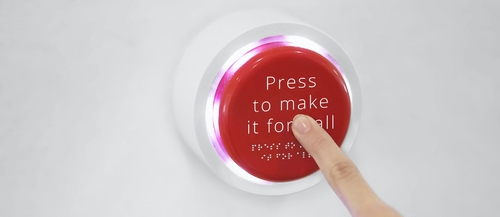Source: Amsterdam Intelligence
Many of us take for granted daily activities such as independently taking public transport, walking in the city center, accessing online services, or going to a restaurant. Unfortunately, this is not the case for everyone. As a city, we have the ambition to offer the same rights to every citizen.
Accessibility is a commonly misused term and it comprises an enormous amount of different subjects and people. Therefore, it can quickly become an overwhelming topic. The last thing we should want is to make accessibility inaccessible by itself. We believe there is a lot that can be improved using AI, but before jumping into solutions, it is crucial to understand what makes a city accessible, whom it serves, and how we can contribute. Here are some steps I suggest to approach the topic.
1. Understanding the problem
Behind the term accessibility
We listen to the term accessibility so often that we tend to forget what it means. Stichting Gehandicapten Platform Roermond defines accessibility as follows:
“Accessibility means that a product or service can be used by everyone, including people with disabilities. Product has a broader meaning here and includes buildings, transportation facilities, ATMs, utensils such as telephones, computer programs and websites.”
The goal is to empower individuals and enable independent living through well-designed and implemented products, services, environment, and devices. People with disabilities should perform and complete their daily activities in a similar amount of time and effort as any other person without disabilities.
We cannot state a building is accessible because it has ramps, or that a website is because blind people can use it. Different people will have distinct requirements and accessible is meant to include everyone.
Source: Amsterdam Intelligence
The disability is on the environment
In the early ’90s, the terminology handicapped was substituted by ‘people with disabilities'. Victor Pineda in ‘Building Cities for All Training program’ defines disability as:
“A person that has, either a long term physical, mental, intellectual, sensory impairment, which in interaction with various barriers, experiences some type of limitation of their participation.”
The new term shifts the pressure away from the people and places it on the environment. The disability refers to the interaction between the environment and the individual. It is up to the environment to create new ways for everyone to feel included. Inclusivity then becomes the most used term. We must progress towards a single solution that fits everyone as much as possible.
Source: Amsterdam Intelligence
Broad scope
Making a city accessible covers many different dimensions. Pineda’s Iceberg of Inequality model presents nine policy dimensions, divided into basic freedoms (represent basic needs) and basic functionings (turn basic freedoms into capabilities). His theory aims to help initiate cross-sectoral reforms in an attempt to improve social justice, equity, and progress for people with disabilities¹.
Pineda's “Iceberg of Inequality” that features basic functioning and basic freedoms. Source: Amsterdam Intelligence
As we can see, a city won’t become accessible only because it has enough curb ramps or audible beacons. It requires a synergy between different fields, where people with disabilities are also heard, supported, and able to participate. Among others, we have to rethink our built environment, public spaces, transportation, ways of communication, services, and public facilities to enable life. A right that everyone should have.
2. Collaboration is key
About 1 in 8 people live with a disability in the Netherlands². There are numerous types of disabilities and combinations. Something that is accessible for someone can be entirely inaccessible for another.
No one can better identify a problem and help coming up with solutions than residents living with disabilities, representative organizations, and field experts.
It is of uttermost importance to include them in debates, workshops, project development, and tests.
3. Being aware of the limitations
A 100% accessible city might be unattainable. These are some of the limitations I have encountered:
- Different people can have contradicting requirements;
- Some situations can be overlooked because of unawareness;
- Different disability types might have an unbalanced representation which reflects on the existing policies;
- Amsterdam areas, such as the old center that dates from the 17th century³, presents an urban pattern that challenges the possibility of good accessibility.
Acknowledging the limitations is crucial to understand what can be done. We have to take one step at a time towards a city as accessible as possible.
4. Basing decisions on tangible evidence
New standards and laws are being created. But how can we measure if accessibility is actually delivered? There is no current way to measure accessibility in the city.
We need tangible evidence to compare outcomes and identify existing bottlenecks.
With this, city officials will be able to make informed decisions and share countable results.
Source: Amsterdam Intelligence
Next steps
We believe Amsterdam Intelligence can play an extensive role in helping to measure accessibility in the city. Together with city officials, organizations and citizens, we are exploring the problems, prioritizing, and, soon, creating solutions.
Firstly, we will be focusing on pedestrian mobility that targets obstructions, pathways, curb ramps, pedestrian crossings, street furniture, signage, parking, and stops and stations. Stay tuned for new developments!
[1] Pineda V.S. (2020) What Makes a City Accessible and Inclusive?. In: Building the Inclusive City. Palgrave Pivot, Cham. https://doi.org/10.1007/978-3-030-32988-4_3
[2] Handicaps in Nederland STERK ONDERSCHAT. HandicapNL. (2020, April 15). https://handicap.nl/blog/handicaps-in-nederland-sterk-onderschat/
[3] Seventeenth-Century Canal Ring Area of Amsterdam. Unesco. (2010, July 31). https://whc.unesco.org/en/list/1349/
Auteur: Cláudia Pinhão
Dit artikel is afkomstig van de website van Amsterdam Intelligence




